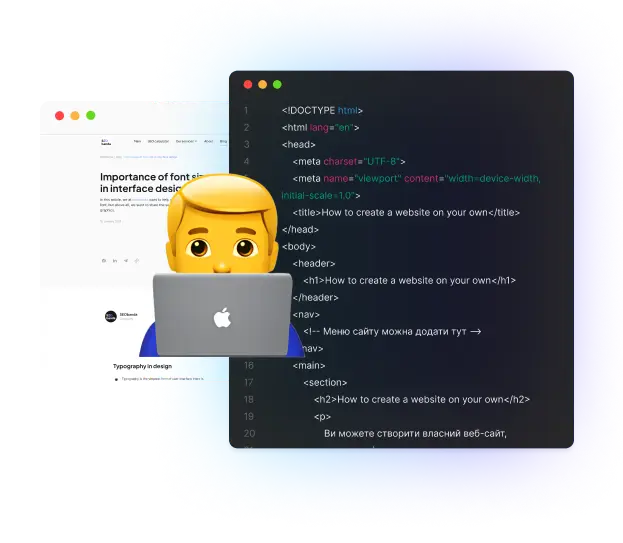Frontend and backend: Basic principles of web development

In a world where digital presence has become not just an advantage, but a necessity, understanding the internal architecture and processes of web development is key to creating effective, dynamic, and engaging websites for users. Behind the scenes of every website that a user visits, there is a division between front-end and back-end development – two sides of the same coin that together form the foundation of any website.
In this post, we will explain the basic principles of the frontend and backend of SEObanda.
What is front-end development?
For us, front-end development is the process of creating a user interface for an application that interacts with customers. It consists of 5 key technologies:
- We create the structure and define the semantics of a web page using HTML.
- We use CSS styles that are responsible for the appearance and positioning of HTML elements on the page.
- We implement the dynamic behavior and logic of your website using JavaScript.
- We use frameworks and libraries to simplify and speed up the creation of web interfaces. Websites developed by us have higher performance, speed, and functionality than websites created using regular JavaScript code.
- We adapt the design to be displayed correctly on different devices (PCs, mobiles, tablets, etc.).
Optimization is crucial for modern front-end development, because most users interact with web products through the interface. Adapted frontend means a better user experience, so it is necessary to carry out high-quality SEO optimization.
When the frontend is optimized, the likelihood that a user will stay on the site and use the service is much higher. Therefore, front-end optimization is key to the success of digital products.
Backend development basics
The backend of web development covers the server side of web applications, which is responsible for the logic of data processing, interaction with databases, as well as integration with other services and systems. The main elements of the SEObanda backend include:
- The backend is developed using programming languages, including Java and PHP. The choice of language depends on the requirements of the project and its complexity.
- Backend websites need a server to process requests from the client (frontend) and send responses. The servers we use can be either physical machines or virtual cloud solutions.
- The backend provides storage, deletion, updating, and querying of data through database management systems (DBMS). These systems can be relational or non-relational.
- We use an API that allows the backend to communicate with the frontend and other external services, providing a standardized interface for data exchange
- Protecting user data and transactions is of paramount importance to us when developing the backend of a website.
We ensure the functionality, speed, and scalability of your website through an integrated approach to backend development.
Results of harmonious interaction between frontend and backend
First, it is a full-fledged functionality – the user sees a user-friendly interface, can interact with various elements, fill out forms, search, and perform other operations. Behind the scenes, complex information processing, database work, analytics, checks, and calculations are taking place.
Secondly, the performance and stability of work even during peak loads. It is thanks to the optimized and scalable backend that the user sees a quick response from the system, not “braking” or freezing.
Third, data security and confidentiality. Reliable backend mechanisms protect personal information from leaks and unauthorized access.
In the world of web development, front-end and back-end are like Yin and Yang – two halves of a whole that harmoniously complement each other. We understand that their interaction and integration is the key to a truly lively and interactive website that the client receives as a result.
Conclusion
Therefore, understanding and skillful use of the basics of front-end and back-end are indispensable components of creating modern, effective web applications. The frontend provides convenience and attractiveness for the user, while the backend is responsible for the reliability, security, and performance of the site. These two areas together form the foundation on which all web projects are built, from simple websites to complex web applications.
SEObanda is convinced that mastering and applying the basic principles of frontend and backend development, as well as integrating modern technologies, is the key to creating innovative and highly effective web solutions.
